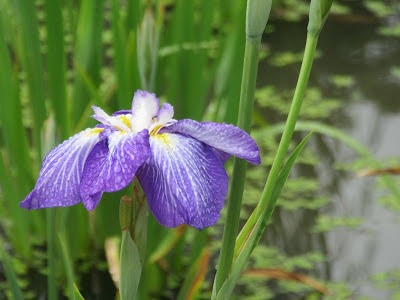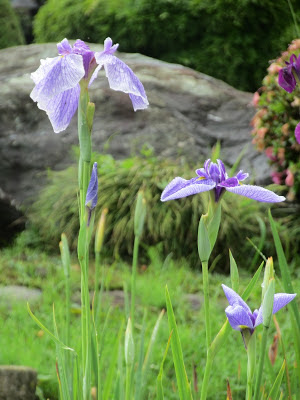すっくと伸びる優美な花菖蒲。きれいですね!
広重は手前に大きな3輪の花、そしてその背景に花の中を散策する人々を描いています。
Don't these flowers look noble and elegant?
They are hanashobu, a kind of iris.
Hiroshige placed three big flowers in the foreground, and in the distance, many flowers and some sightseers.
ここは堀切村。現在の葛飾区です。
この辺りはもともと低湿地帯で花菖蒲の栽培に適していました。
江戸時代この地には小高園、武蔵園、吉野園、堀切園、観花園の5つの菖蒲園があり、6月の花菖蒲の季節になると、江戸から舟で隅田川、綾瀬川を上って、花菖蒲を見に来る人がたくさんいたそうです。
This is the village of Horikiri, which is now in Katsushika ward.
In the time of Edo, it was a swampy area, good for hanashobu cultivation.
There were five famous hanashobu gardens in the village, Kodaka-en, Musashi-en, Yoshino-en, Horikiri-en, and Kanka-en.
During Hanashobu season in June, a lot of Edo people took a boat up the Sumida and Ayase River and visited the place.
現在は堀切園だけが堀切菖蒲園として残っています。
Now only Horikiri-en remains as Horikiri Shobuen (Horikiri Iris Garden).
もう見頃も過ぎそうだというので慌てて小雨が降る中、行ってきました。
Afraid to miss its best season, I headed for the place in a drizzling rain.
京成電鉄堀切菖蒲園駅 Horikiri Shobuen Station of Keisei Line
駅からは徒歩約10分。看板があちこちに立っているので、ちっとも迷いませんでした。
The garden is about 10 minutes walk from the station.
Thanks to the signs everywhere, I didn't get lost.
6月1日から25日まで菖蒲まつりが行われています。
From June 1 to 25, they are having Shobu Festival.
花はみごとでした。
Flowers were so gorgeous.
下の写真、赤い高速道路の向こうを綾瀬川が流れています。
江戸の人々が船で来れば簡単に来られましたね。
でも車の音がけっこううるさかった。(>_<)
You see the red highways? The Ayase River is just beyond it.
You can see how easy it was for Edo people to come here by a boat.
But because of the highways, it was quite noisy. (>_<)
ここには200種類、6000株の花菖蒲があります。
200種類ってすごいですね。
There are 200 kinds, 6000 hanashobu in the garden.
Why so many varieties?
江戸後期、朝顔や菊同様花菖蒲の品種改良も大流行。そんなわけで次々と新しい色や形の新種が作られたんだそうです。
In late Edo, breeding flowers became so popular. Horikiri gardeners raced to produce more colorful and more exotic hanashobu.
これが原種、野花菖蒲です。
This is the original flower.
野花菖蒲 Nohana Shobu
そこからいろいろ作られて、
Then, the hybrids come in so many varieties.
.jpg)
名札が立っているのでわかりやすいです。
It's nice they are labeled, but sorry, in Japanese. (-_-;)
花を見て、名前を見て、なんでこんな名前になったのか考えて、なんだか楽しい!
I had fun looking at the flowers, looking at the names, and thinking why they got such names.
たとえば、
For example,
江戸紫 (これは納得。) Edo Murasaki (Edo Purple)
.jpg)
堀切の夢 Horikiri-no Yume (Horikiri Dream)
.jpg)
綾瀬川 (青いからですかね?) Ayase River
.jpg)
燭光錦 (とてもきれいでした。) Shokko nishiki (in English, it's something like light of a candle)
.jpg)
遊女の姿 (背が高いからでしょうか?) Yujo-no-sugata (Image of courtesans)
.jpg)
深窓佳人 (遊女と比べてどうなんでしょう??)
Shinso Kajin (a noble madame)
.jpg)
葵の上 (そんな感じ) Aoinoue (the heroine of Tale of Genji)
カタカナ名前もありました。
Some have katakana names.
スティップルド・リップルズ (点々のついたフリルって感じでしょうか?)
Stippled Ripples
Stippled Ripples
プリマ・バレリーナ (納得!)Prima Ballerina
本当にきれいでした。
広重の絵のような写真を撮るのもなかなか面白かったです。
でも思うようにはいかないもので。
たとえば下の写真。花の形はとってもいいと思うんですが、背景が石ではね。
I really enjoyed the flowers.
Also, it was fun trying to take a photo as close to Hiroshige's print as possible.
But it wasn't easy.
For example, I like the flower in this photo, but not the background.
![]()
清少納言 Seisho Nagon
というわけで、選んだのがこれです。
So, I've chosen this.
![]()
![]()
小紫 Komurasaki (Little purple)
\(^o^)/
本当にきれいでした。
広重の絵のような写真を撮るのもなかなか面白かったです。
でも思うようにはいかないもので。
たとえば下の写真。花の形はとってもいいと思うんですが、背景が石ではね。
I really enjoyed the flowers.
Also, it was fun trying to take a photo as close to Hiroshige's print as possible.
But it wasn't easy.
For example, I like the flower in this photo, but not the background.
.jpg)
清少納言 Seisho Nagon
というわけで、選んだのがこれです。
So, I've chosen this.
.jpg)
.jpg)
小紫 Komurasaki (Little purple)
\(^o^)/
.jpg)
.jpg)
.jpg)
.jpg)
.jpg)
.jpg)
.jpg)
.jpg)
.jpg)
